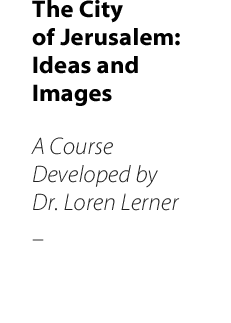


Why I Developed This Course on Jerusalem
The Azrieli Institute of Israel Studies was established in 2011 thanks to a generous gift by the Azrieli Foundation to a University in Montreal. In 2013, as a member of the Advisory Board and after a sabbatical in Jerusalem, I developed this art history course for the Minor in Israel Studies, the first and only undergraduate program of its kind in Canada. My objectives were:
-
to examine forms of artistic expression including architecture, sculpture, painting and other media from across a variety of cultural identities so as to encourage respect for the art of these different communities
-
to demonstrate how an expanse of history depends mainly on how one reads the evidence
-
to encourage an understanding of human experiences from the viewpoint of others who interpret the world in significantly dissimilar ways
-
to integrate a large historical perspective that reveals the changes in the art of particular eras, as well as the continuities of religious, ethical and social values
-
to explore artistic productions and cultural practices that construct identity, influence public discourse and act as catalysts for social and political changes
See interview on Imagining Jerusalem website:
https://jerusalems.wordpress.com/2015/03/16/teaching-jerusalem-loren-lerner-concordia/
As a recently retired professor, I share with you the lectures I developed, the readings consulted, and the annual student journal I produced which contain the very best essays and works of art by the students in that year’s class.
Dr. Loren Lerner
DESCRIPTION
Over the centuries, Jerusalem has been called Shalem, Yerushalayim, City of Melchizedek, City of the Great King or City of David, prototype of the Heavenly Jerusalem, Bayt al-Maqdis or al-Quds, and City of Peace. My lectures consider these different attachments to Jerusalem through visual perceptions and artistic representations at the religious, social, and political levels. They examine Jerusalem's multifaceted religious narratives, allegiances, and believers’ ideas since the time of the Hebrew Bible. Beginning with the Bronze Age and the First and Second Temple periods, these lectures cover the city's history: the Roman period, Byzantine Jerusalem, the Arab, Crusader, and Mamluk periods, the years under Ottoman rule (1517-1917), the British Mandate (1917-1948), Jerusalem's division and reunification (1948-1967), and Israel today.
Available to the public and as an online contact for free
For more information contact lernerloren@gmail.com
AND WATCH
THE LECTURES
- Click on the link to download the lecture to your computer, these are large file sizes, it will take some time to download
- Open the Power Point Presentation, in the main menu choose View > Enter Full Screen (to hear the sound recordings for each slide.
- The arrows on the bottom left will help you navigate between the slides, the sound icon is placed on the bottom right of the screen
LECTURES
Each lecture is about two hours long.
Lecture 1
Jewish Yerushalayim
184MB
Download_
Lecture 2
Christian Hagiapolis Ierousalem/ Hierosolyma
199MB
Download_
Lecture 3
Muslim Al Quds
230MB
Download_
Lecture 4
Jerusalem and the Crusader Period (1095-1291)
230MB
Download_
Lecture 5
Islamization of Space and Society
in Ayyubid (1187-1250)
and Mamluk Jerusalem (1260-1517)
156 MB
Download_
Lecture 6
Ottoman Jerusalem
and Modernization (1516-1917)
190 MB
Download_
Lecture 7
Pilgrimages to Jerusalem, the Way of the Souls
200 MB
Download_
Lecture 8
Heavenly Jerusalem, New Jerusalem
240 MB
Download_
Lecture 9
British Presence in Nineteenth Century Jerusalem and during the British Mandate (1916-1948)
160 MB
Download_
Lecture 10
Israeli-Jewish artists and Zion
185 MB
Download_
Lecture 11
Palestinians Artists, Nationalism
and Self-Determination
205 MB
Download_
Lecture 12
Jerusalem To-day: Architecture,
Urban Space and Contested Identities
112 MB
Download
return to the top of the page
_
SOURCES
BIBLIOGRAPHY
+ JOURNAL
+
HANDOUTS
These are the sources I consulted to develop this course they are organized by lecture.
In addition, I have included basic and important sources available online.
Download Word Document
_
See also:
The Jerusalem Art History Journal: An Undergraduate eJournal/Histoire de l’art à Jérusalem : cyberrevue étudiante de premier cycle was created for educational purposes. Each week in addition to scholarly sources the required readings included the student writings and works of art I selected for the journal. The students had a choice of two assignments. The first was to write an essay about the art, architecture, archaeological sites, or urban spaces from a particular era of Jerusalem. Since a good many of the students are artists in Concordia’s studio arts programs, the second choice was to create and write about a work of art, reflecting a visual response to this ancient city as a site of major world religions. The objective was to examine how the art, architecture, and material culture of Jerusalem have been shaped by the city’s religious importance and by the various ethnic and religious groups that have resided in the city throughout its history. http://jerusalemjournal.concordia.ca
Some of the volumes of the journal have a particular theme. For example, the theme for Volume 5 was to write an essay or create work/s of art beginning with one to three works from the Israel Museum.
Vol.05 | Vol.04 | Vol.03 | Vol.02 | Vol.01
_
These are the handouts I prepared to help the students develop better writing and analysis skills:
How to write an art history paper
Download Word documentHow to analyze a work of art
Download Word documentHow to write about buildings
Download Word documentHow to analyze a photograph
Download Word documentHow to analyze a film
Download Word documentHow to use the senses to analyze art and architecture
Download Word documentHow to analyze a scholarly reading
Download Word document_
Examples of How to Relate Works in Israel Museum to Course Material and Related Readings
DownloadJerusalem in the Israel Museum
Download
For use as course curriculum worldwide,
permission must be granted by Loren Lerner
loren.lerner@sympatico.ca